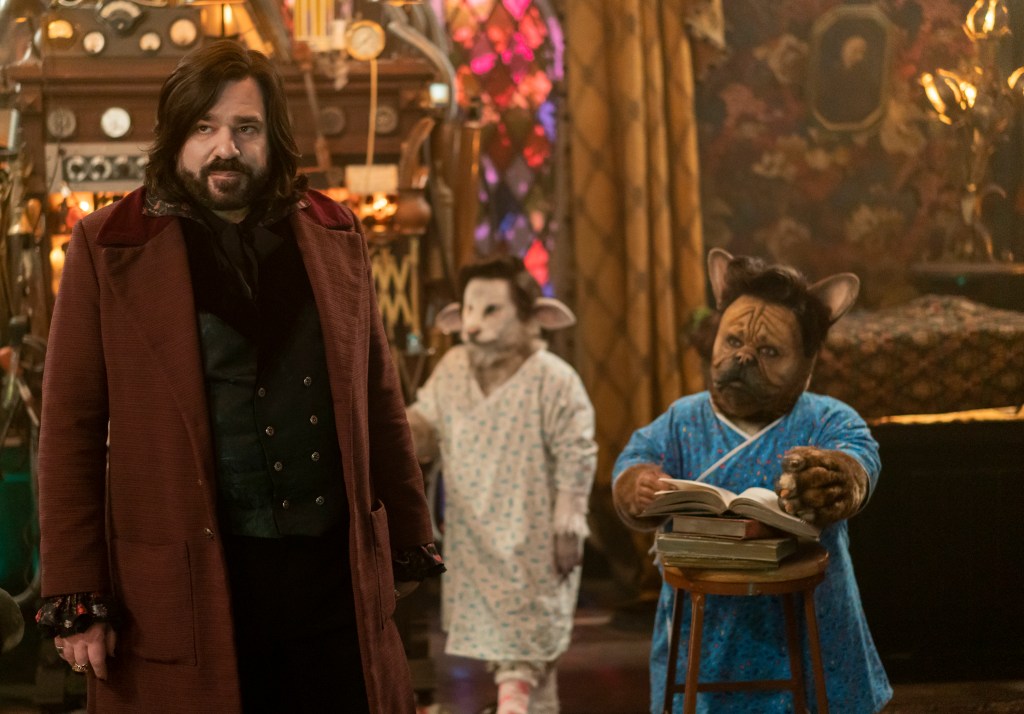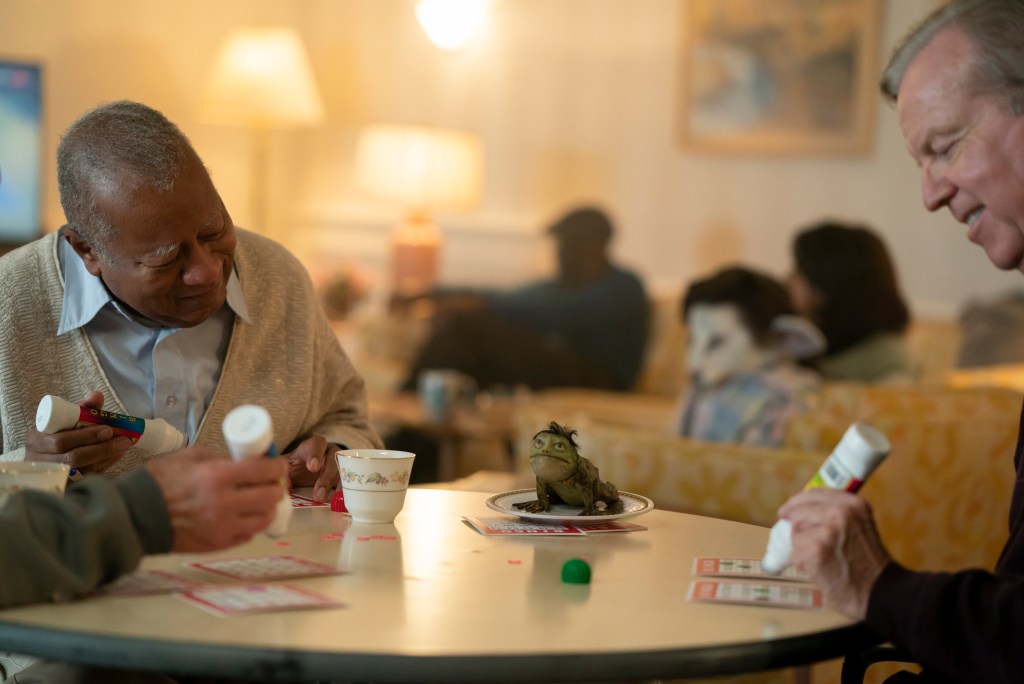What We Do in the Shadows: How Were Those Guillermos Created?
Prosthetics designer Paul Jones breaks down the Staten Island menagerie of furry Guillermos in What We Do in the Shadows.

This article does not spoil plot points WHAT WE DO IN THE SHADOWS season 5 episode 7, but reveals how certain special effect scenes are done.
The title of What We Do in the Shadows season 5 episode 7 “Hybrid Creatures” gives away the guest stars who hide their true selves behind bleats, ribbits, and floor-burning flatulence. Laszlo (Matt Berry) deems his experiments to slow vampiric progression a failure, and orders scientific containment. Guillermo (Harvey Guillén), the one evolving into a vampire, is the container. He is given a sidearm to dispatch of the monstrosities created when science gets mad.
To understand the workings of the former familiar’s curious evolution, and a few giggles, Laszlo has been splicing Guillermo’s DNA with stray animals. We’ve already seen Guillermo’s face on levitating frogs, but now there is a whole litter to be cleaned. The vampires have an infestation of Guillermo-things, and there’s not an exterminator in the underworld who can root out the abomination. Luckily, the creatures’ creator can.
Prosthetics designer Paul Jones joined What We Do in the Shadows virtually from the beginning of its FX run. “I came on board episode 2 season 1 and I’ve pretty much been on board the show ever since,” Jones tells Den of Geek. As Laszlo converts his study into his own personal “Island of Dr. Moreau,” Jones is the architect of all the castoffs. Speaking with Den of Geek, he breaks down the costuming, prosthetics, and puppetry of the many Guillermos seen in “Hybrid Creatures.”
Den of Geek: Harvey Guillén talked about the casting of his back for the batwings, and how weird it felt getting the peel. Will you explain the process of casting his head?
Paul Jones: We’re now living in a digital age. The technology progressed to where we can have an actor, Harvey for instance, go to a facility in Los Angeles, and be scanned for 20 minutes. His information was sent to us in Toronto. We created a head cast from that digital scan. Having that digital information, I was able to take Harvey’s face and miniaturize it as a starting point for the rat and frogs. It’s the first time we’ve done it on the show, to my knowledge.

There’s no need to stick breathing tubes up the nose?
In previous episodes, we’d do a live cast, using silicone and plaster. We did many versions of Mark [Proksch, who plays psychic vampire Colin Robinson]. They started with a life cast. We scanned Mark’s face, and printed it smaller. The scan we got from Harvey was much cleaner. We were able to make a fake dummy, for carrying him around in last week’s episode. We were able to make all the basics for the hybrids, because they were supposed to look a little bit like Harvey. The rats and the frog started with Harvey’s face. And of course, Binky [the most fragile of the creatures made from Guillermo’s DNA, it is aquatic].
How did Binky float above the others?
I’d done a water effect previously on a show many years ago. I did some tests, and found it’s not going to be the same because he’s more of a character. We have to build two versions. But once it went into the water, I thought ‘this effect is going to steal the show.’
So much of this was practical effects besides the digital casting, are there computer-generated effects?
We pride ourselves on the practical way of doing everything. When I first started on the show, everything was practical. That was their established aesthetic. It’s guerilla style filming. It’s handheld. It’s a documentary. The animals are 100% practical, except for VFX tweaks.
It started with the Nadja doll. She has a lot of dialogue and has to have a fully puppeteered mouth, like they do with Chucky. I didn’t think I could pull it off in time. But the SFX team is very good. If I do everything else, and leave the mouth closed, the effects [team] can make it talk.
For instance, Harvey’s rat character, even though we have a servo [a puppet controller], control jaw, and all the body movements are rod-puppeted, their heads only are this big [holds fingers about two inches apart]. To have facial expressions in such a small space is almost impossible. But the effects are like “don’t worry, we’ll make it blink, we’ll make it frown, we’ll make it smile, we’ll do all that. Because you’ve given us 90% of the work, we’re just going to take that and then tweak it.”
These creations are a combination of actors in costumes and mechanical creatures. Which are easier to work with?
They both bring their own challenges. I like puppets, because you don’t have to wait for casting. When you’re doing makeup on somebody, you have to wait for the actor to be hired before you can do head casts, body casts, and fittings. But with puppets, you can create it without any external characters.

You put a lot of work into creatures who get less than a second’s screen time.
It doesn’t matter to me, as long as it works in the story. There are very few close-ups on this series. We zoom in, and we zoom out, because it’s all handheld. It was a different way of filmmaking when it comes to a prosthetic effect. In regular filming, it’d be a fake head to this point, then we’ll cut away, and cut back to a close up, then to a medium shot. I did that in one of my first meetings in season 1, and they said “We don’t do that on the show.” They edit in the take. Every scene is an entire master. So, it’s very rare that we cut away to anything.
We’ve gone on to use two cameras. I had to change the way I design every effect, because I know the whole thing has to happen in camera. So, [during shooting] we would have the wings on Harvey, which would start closed, then he would walk in, sit down and then open the thing. I couldn’t have cables running across the set. Everything had to be self-contained. It really added a different mindset when we’re creating the characters.
You remember the first piece you designed for Shadows?
The werewolf, in season 1 when it jumps off the roof. That was the biggest thing we’d done to that date. I was adamant to give them a fully self-contained seven-foot-tall werewolf. They said this has got to run on the roof and jump over the edge because we’re gonna get leg extensions. It’s going to be a stunt guy, Jeff. He’s amazing. He had the stilts. I was full of enthusiasm to give them more than they needed.
Do you have to have after-creation discussions with the actors? Like on how to talk with these things on?
Whenever you’re doing a prosthetic, the first thing you say to somebody is, look in the mirror, and make your normal acting face. And they go, “Oh, I can’t see anything.” The makeup is there, you’re adding to someone’s face, so you need to act through the makeup. Every smile needs to be 50% bigger, every frown needs to be 50% bigger. It may seem like you’re overreacting, but when you’ve got a dog face on, it’s not going to look that way.
One of the delights of the show was to work with Doug Jones [who plays Baron Afanas], because he’s such an icon in the sci-fi/fantasy genre. Within my community, it’s an unwritten rule that you wouldn’t really make it unless you’ve done a makeup on Doug Jones. He’s so prolific. And he’s such a pro. Honestly, I was terrified. He was Abe Sapien. He was Silver Surfer. He was Billy from Hocus Pocus. After about five minutes, he goes, “Oh, you actually know what you’re doing.” That is the biggest compliment you can get. Now he’s a regular character.
What We Do in the Shadows airs Thursdays at 10 p.m. on FX.
